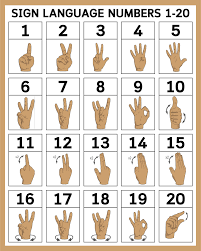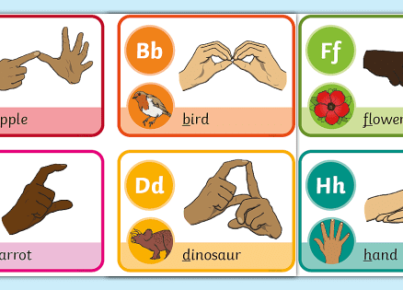1. Introductory lessons: Begin by teaching your students the alphabet and numbers in sign language. Start with simple letters and numbers, gradually progressing to more complex formations.
2. Visual aids: Incorporate visual aids such as posters, charts, and flashcards to help students learn and remember sign language symbols.
3. Incorporate videos: Show educational videos featuring sign language conversations or stories, allowing students to see how signs are used in context.
4. Game time: Organize games and activities that require students to use sign language, such as memory games, charades, or bingo.
5. Storytelling: Encourage students to create stories or retell existing ones using only sign language.
6. Performances: Have students prepare and perform skits or plays using sign language, fostering teamwork and creativity while practicing their skills.
7. Songs and rhymes: Teach popular songs or nursery rhymes in sign language for a fun group activity that strengthens memory and understanding.
8. Pair work: Assign students a partner with whom they can practice signing conversations regularly to build confidence and fluency.
9. Deaf culture studies: Introduce your class to Deaf culture by studying history, community events, and prominent figures who have contributed to the world of sign language.
10. Guest speakers: Invite members of the Deaf community or experienced sign language interpreters to visit your classroom for presentations or Q&A sessions.
11. Silent days: Designate specific days where speaking is prohibited in the classroom, encouraging students to fully immerse themselves in signing communication.
12. Role reversal: Ask students who are already knowledgeable about sign language to take on the role of teacher for the day, giving them an opportunity to share their expertise with classmates.
13. Puzzle pieces: Create a puzzle with images of different signs that students must assemble correctly through group collaboration.
14. Art projects: Incorporate sign language symbols into painting, drawing, or sculpture projects that allow students to express themselves creatively.
15. Reward system: Implement a point-based reward system for the correct use of sign language in the classroom, motivating students to practice and improve their skills.
16. Real-life scenarios: Prepare your students for real-life situations by having them practice ordering food, asking for directions, or introducing themselves using sign language.
17. Scavenger hunt: Organize a scavenger hunt where clues are written in sign language, requiring students to work together to solve riddles and reach the final destination.
18. Field trips: Take your class on outings to Deaf events or local institutions that promote signing communication, providing firsthand exposure and valuable learning experiences.
19. Technology integration: Utilize apps and technology designed specifically for learning sign language to aid in teaching and practicing new signs.
20. Interactive quizzes: Reinforce sign language acquisition through engaging quizzes that provide immediate feedback, helping students understand their progress and areas needing improvement.
By incorporating these 20 creative methods into your classroom curriculum, you’ll not only foster a fun and inclusive learning environment but also empower your students with valuable communication skills that will benefit them throughout their lives.



